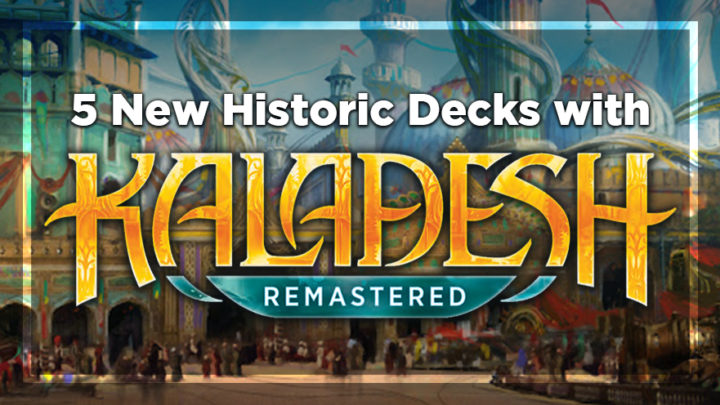Kaladesh Remastered comes out today, and with its release, we should see a big shakeup in the Historic metagame. This set warped Standard when it was first introduced and led to a series of Standard bannings for the first time in nearly a decade. While some of Kaladesh block’s most powerful cards — like Felidar Guardian, Smuggler’s Copter and Walking Ballista — have been left out of the set, there are still some cards that are going to have a major impact on Historic. Today, I’d like to offer five potential new decks to get you ready to battle in the Historic queues this weekend.
But before we get into the decks, we have to talk about the mana that makes them possible.
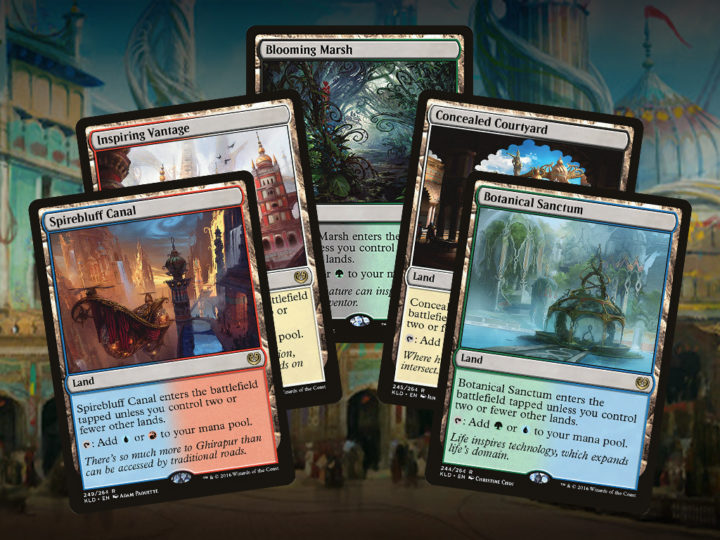
Mana is an element of aggressive decks that players often overlook. If you’re playing a multicolored aggressive deck, you’re often sacrificing consistency and a long game for short term gains. That means you need to be playing a spell every turn of the game, and your mana base will make or break your game plan. Having good mana in your early turns will allow you to consistently play on curve and minimize that consistency hit.
The enemy-colored “fast lands” will enter Historic with Kaladesh Remastered, and they’ll give strategies other than Mono-Red or Gruul the mana they need to finally gain a foothold in the format. I would look at playing Blue Red, Red White, Black White, Blue Green, or Black Green aggressive decks in the next several weeks. With these lands, the shock lands, the Pathways, and the check lands, you can expect a lot more consistent, curve-out games.
Mardu Aggro
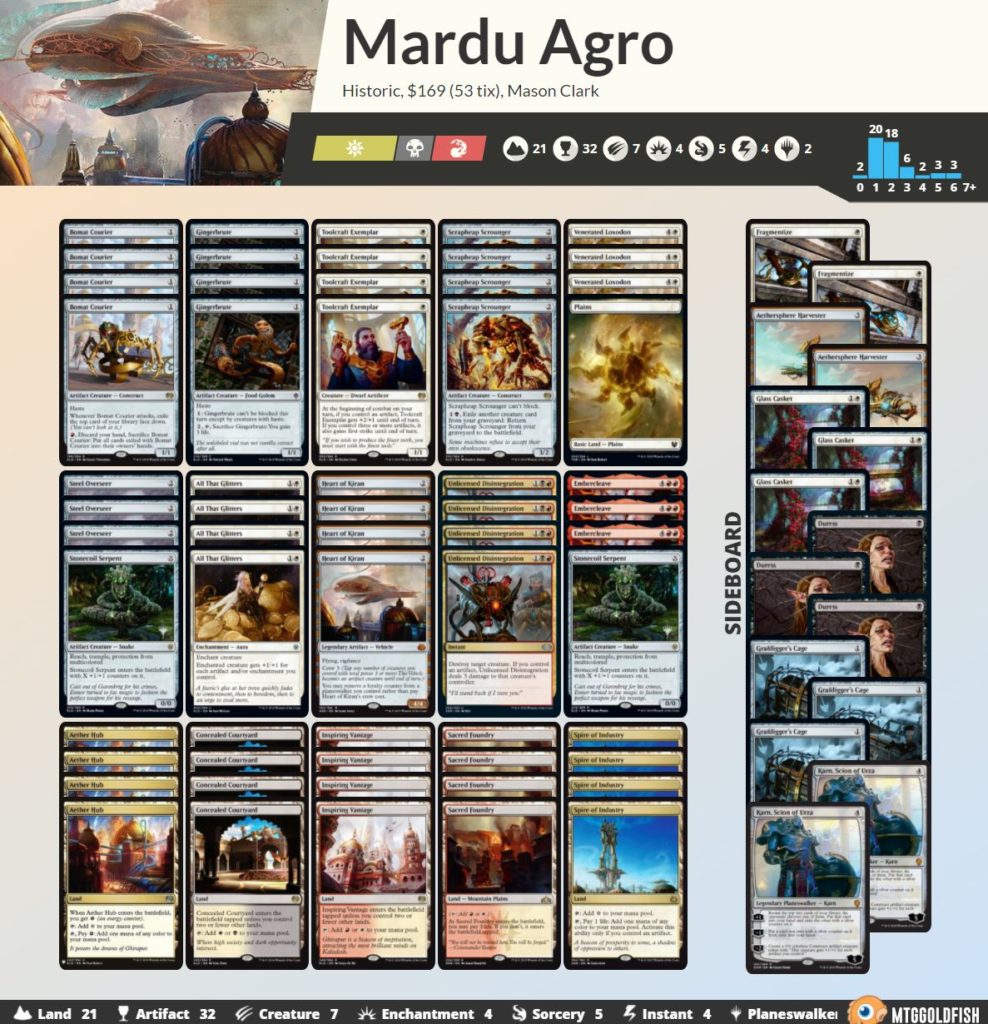
Buy this deck from Card Kingdom
Export this deck to Arena via MTGGoldfish
With that in mind, I started by building this Mardu Aggro deck. Not only does it make use of the Concealed Courtyard and Inspiring Vantage, but it uses Spire of Industry to help fix your mana in the early game.
This deck also incorporates some powerful aggressive cards from Kaladesh. Toolcraft Exemplar allows you to quickly get on the battlefield and apply pressure, while Scrapheap Scrounger gives you some late game staying power. Both of these cards also crew the all-star vehicle of the deck: Heart of Kiran. Heart is a standout because it allows you to play around board wipes, it gives your creatures pseudo-haste by allowing them to crew it, and it’s just a large, evasive threat. Expect Heart of Kiran to be a big player in Historic.
All these untapped, multicolored mana sources and powerful, colorless early game spells allow you to splash for game-winning cards like Unlicensed Disintegration and Embercleave. Unlicensed Disintegration didn’t get much love when the set was previewed, but I expect it to be an all-star in these sorts of decks. An unconditional removal spell that often deals three damage to the player and works with your main game plan is a recipe for success.
Many of these cards were part of the powerful Mardu Vehicles shell in previous Standard formats, and I expect them to be just as successful in Historic.
Mono-Red
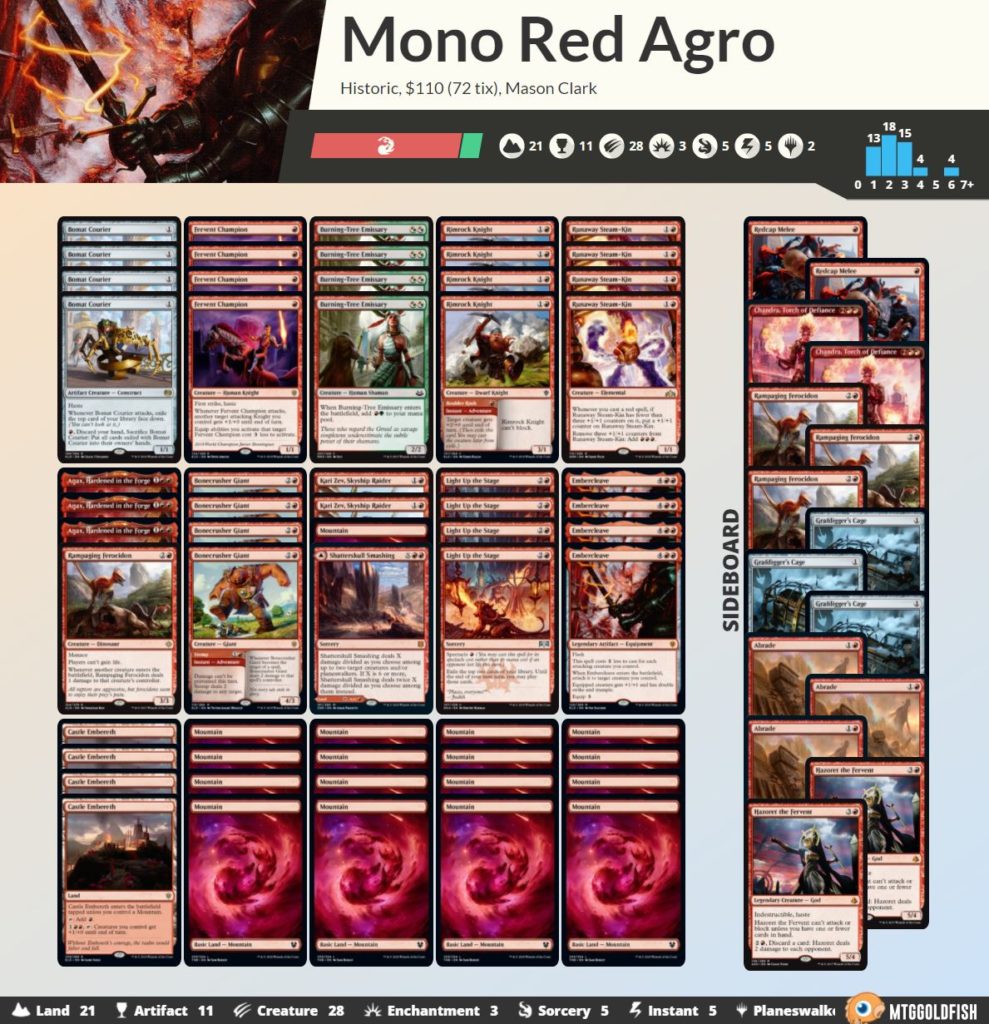
Buy this deck from Card Kingdom
Export this deck to Arena via MTGGoldfish
Mono-Red picked up some strong cards when Amonkhet Remastered came out, and the same can be said for this latest release.
First, Bomat Courier joins the deck. Current red decks are playing Fanatical Firebrand as a one-drop; while it’s a fine card (I had the honor of losing to a Fanatical Firebrand playing for Top 8 of a Modern SCG Open), Bomat Courier is a serious upgrade. Bomat allows you to apply early pressure while being able to refuel in the mid- or late-game. It opens up the ability to trade cards off more aggressively without running out of steam; other one-drops don’t offer that kind of flexibility in game plans.
Another addition is Kari Zev. While it’s not an automatic four-of like Bomat Courier, Kari Zev is a fine one-of for lower to the ground red decks. Kari almost always gets in for at least one damage, and she often puts the opponent in the awkward position of having to waste resources on Ragavan. Kari also counts as two creatures for Embercleave, which will allow for more consistent turn three Embercleave starts, especially now that Burning-Tree Emissary is off the suspended list. This emphasis on two-drop creatures seems like the best way for red decks to push through decks that are playing cards like Uro and Cat/Oven.
Mono-Red also gains the powerful Chandra, Torch of Defiance in the sideboard. We can bring Chandra in for long, drawn-out games; she doesn’t provide the burst of cards that Experimental Frenzy can, but she better suits our game plan. Chandra’s mana ability is often slept on, but in this deck, it’ll allow us to cast two spells on turn four consistently and can even be used to cast a Embercleave pre-combat, if need be. If you have not played with Chandra before, she might appear to be unimpressive, but after your first couple of games, you will quickly find out why she was a format-defining all-star.
Mono-Red is a strategy that ebbs and flows with the Historic metagame. If you catch it at the right point, the deck is very impressive; other times, it’s just a fine choice. I think these new additions will bring the power level of this deck in line with the rest of the format on average.
BW Auras
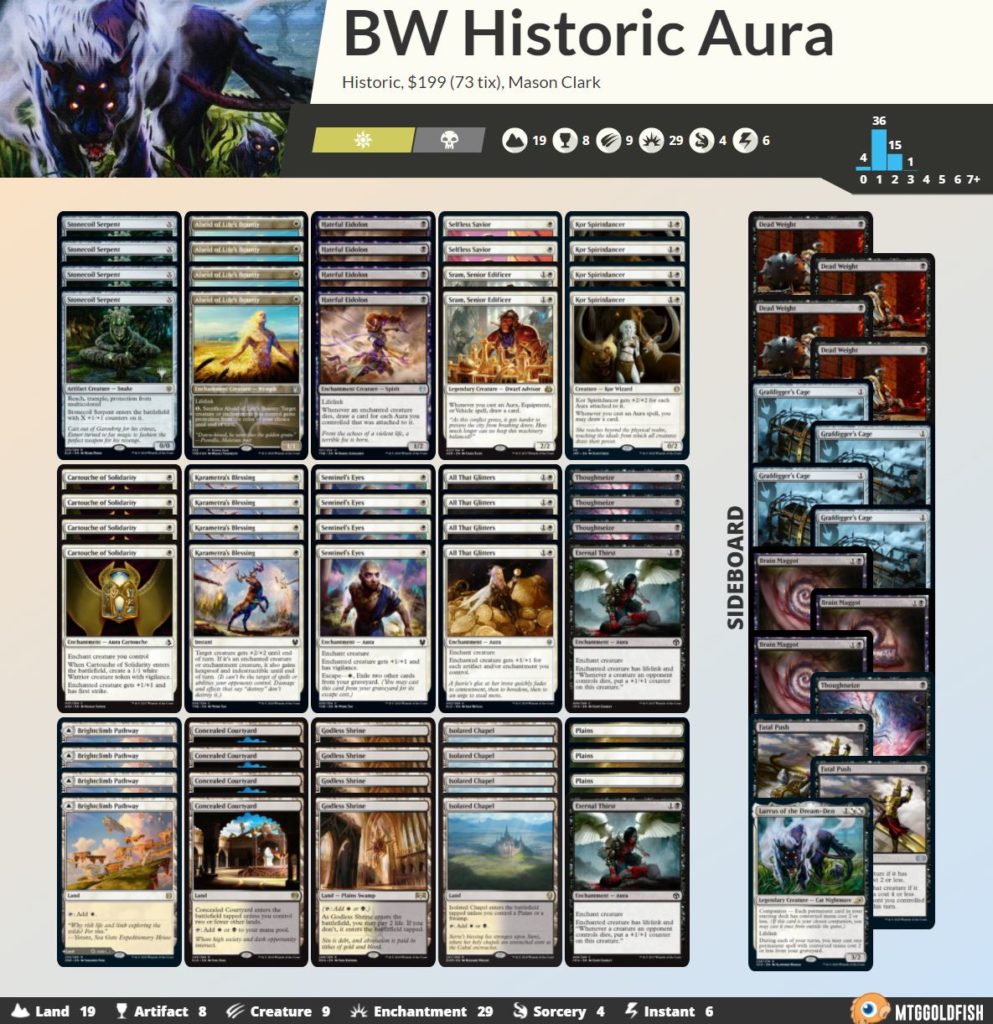
Buy this deck from Card Kingdom
Export this deck to Arena via MTGGoldfish
Another aggressively slanted card we got in this set is Sram, which easily slots into the Blue-White Auras deck that has been a mainstay in the format since Jumpstart. While Sram is legendary — a drawback we don’t see on Kor Spiritdancer — this sort of effect is so pivotal that I’d expect Sram to become an auto-include, maybe even a four-of.
Blue-White Auras may still be a strong contender, but I think this Black-White version is an upgrade. This deck looks a lot like a build that we first saw in Pioneer; it plays a lot like the Blue-White Aura deck, but leans more into the enchantment theme while also using black’s discard as its form of interaction. While Blue-White must leave mana up for cards like Dive Down or Aether Gust in post-board games, this deck proactively looks to solve those problems by playing cards like Thoughtseize to clear a path for our suited-up creatures. This also allows you to know what your opponent is packing and how best to play around it.
You may decide that you want blue’s forms of interaction in certain metagames and black’s in others, but I imagine this deck will be a big player in the metagame. It’s a great way to attack midrange piles without engaging in an arms race. Whether you’re looking to play interactive or non-interactive games, this is a great place to start in Historic.
UG Marvel
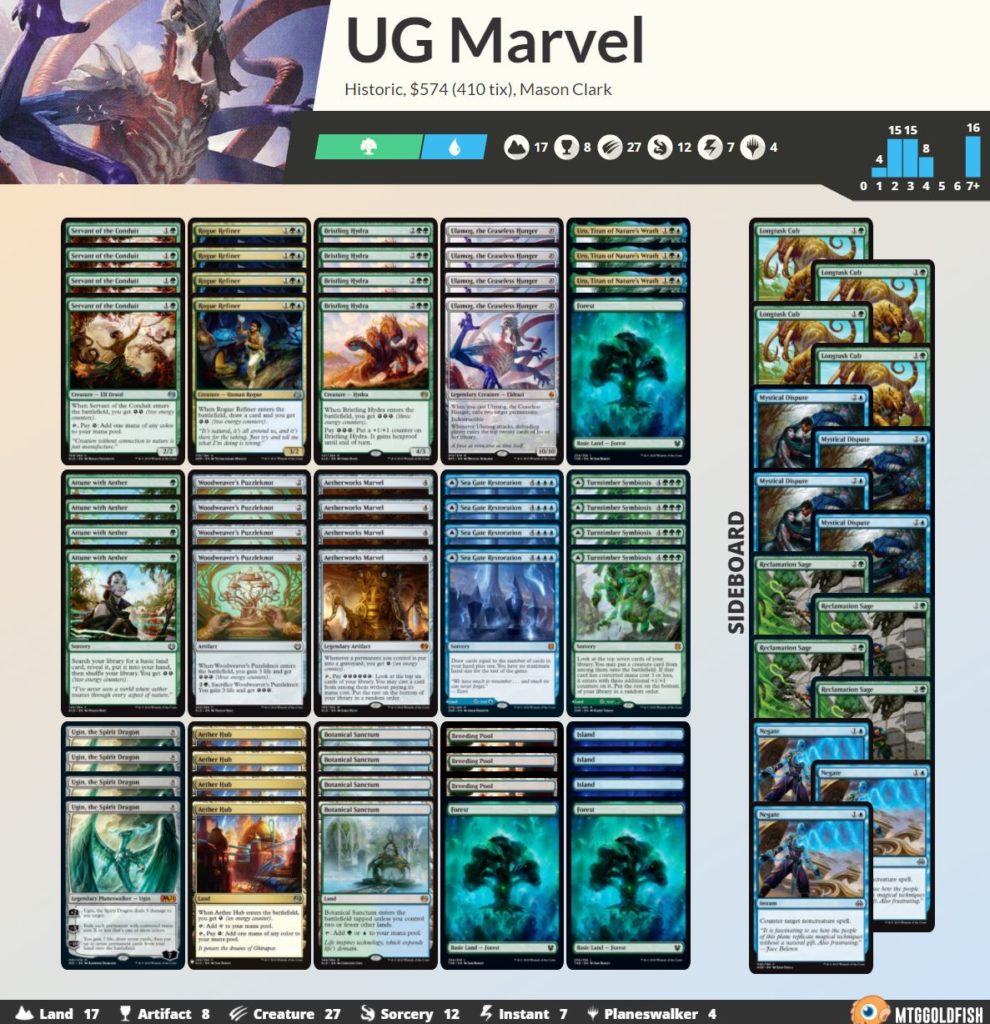
Buy this deck from Card Kingdom
Export this deck to Arena via MTGGoldfish
Aetherworks Marvel was a menace in Standard. In Historic, we have a lot more potential answers to this slot machine, but that doesn’t mean that Marvel doesn’t stand a chance of dominating. Historic is a format that typically doesn’t have enough decks that can end the game before Marvel gets out of control. Unlike Pioneer — a format where Marvel has been virtually nonexistent — turn four wins are relatively rare in Historic, so Marvel may be able to outvalue its way to victory here.
We’ve also gained more things to hit off of Marvel. While Ugin and Ulamog are at the top of many players’ minds, the Zendikar Rising mythic lands jump out to me. Miss on hitting Ulamog? You just might hit a Turntimber Symbiosis. Want to try again? You also get Sea Gate Restoration, which will let you refuel on energy. These are basically free includes — lands with upside.
The Historic metagame doesn’t really have a deck like this outside of Goblins, and Goblins is a deck that you can very easily beat, if you want to. While Marvel might end up being the same, I have my doubts. For starters, your opponents need to interact with your Marvel plan while still respecting your on board presence; your Bristling Hydras are a fine place to sink your energy. This combined with the ability to have a potentially transformational sideboard have me thinking this might be the better “spin the wheel” deck.
You could move this deck in a less “all-in” direction that simply uses Marvel for value. Cards like Nissa, Who Shakes the World are still good Marvel hits if you’re looking to go that direction instead of Ugin. Either way, Marvel is going to be the talk of the format for the next couple days as players look to see if the format will break under the pressure.
Paradoxical Storm
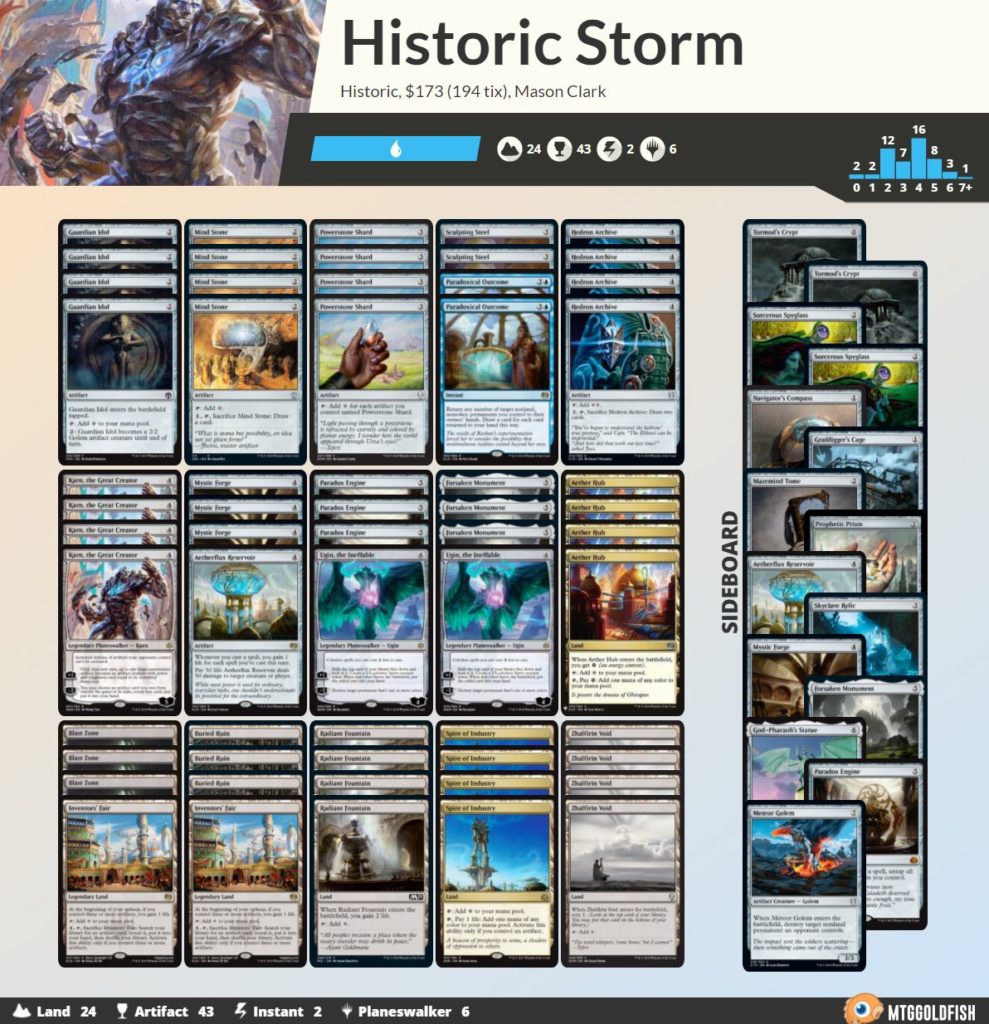
Buy this deck from Card Kingdom
Export this deck to Arena via MTGGoldfish
Paradoxical Storm has a clear game plan: make mana with mana rocks and Paradox Engine, cast Paradoxical Outcome to pick them all up, cast an Aetherflux Reservoir (or Karn to grab one from the sideboard), and shoot your opponent for 50 damage. We also have cards like Mystic Forge which will allow us to quickly move through our deck once we have Paradox Engine in play.
This deck is a bit of a leap, but I think it could be the start of a truly impressive combo deck. Historic has been dominated by midrange decks lately, so having a combo deck that can win as early as turn five is very appealing. Generating essentially infinite mana will be easy with this deck, as will winning once you get everything online.
That said, Jund’s faster draws and the potential rise of aggro decks are causes for concern. If those fears turn out to be justified, I would try cleaning up the wish board. A lot of the time, you won’t need as many tutor targets, and you can focus on a match-up you want to beat instead.
This deck will need to be refined over time, but for right now, I’m really happy with it and excited to see what happens when the community gets its hands on it.
These five decks are just the tip of the iceberg when it comes to brewing with Kaladesh. I didn’t even get to mention cards like Metallic Mimic, Winding Constrictor, Refurbish, Blossoming Defense, or Hidden Stockpile. This set will really shake up the Historic metagame, so get on the ladder and show the world what you can invent with these new cards.
Have a deck you love? Tweet it at @masoneclark and @card_kingdom!

Mason Clark is a grinder in every corner of the game who has played at the pro level and on the SCG Tour with Team Nova. Whether he’s competing in Standard, Historic or Modern, Mason plays with one goal in mind: to be a better player than he was the day before. Check out his podcast, Constructed Criticism, and catch his streams on Twitch.

